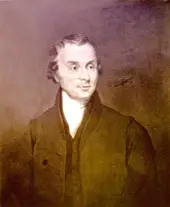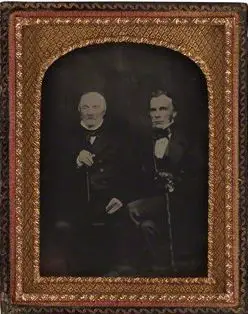
Luke Howard m. Mariabella Eliot (1769-1852) Lloyd H Fox was the 2nd great grandson of Luke Howard
A photograph of Luke with his son John Eliot is in the National Portrait Gallery collection
Both the US & the Falkland Islands have issued postage stamps featuring clouds with the classification systen devised by Luke Howard
source: Wikpedia.
Luke Howard, FRS (28 November 1772 – 21 March 1864) was a British manufacturing chemist and an amateur meteorologist with broad interests in science. His lasting contribution to science is a nomenclature system for clouds, which he proposed in an 1802 presentation to the Askesian Society.
Career
He was born in London, the son of Robert Howard, a lamp manufacturer, and educated at the Quaker school in Burford, Oxfordshire. He was a Quaker, later converting to the Plymouth Brethren, and became a pharmacist by profession. After serving an apprenticeship with a pharmacist in Stockport, Cheshire he set up his own pharmacy in Fleet Street in 1793. Around 1797 he then went into partnership with William Allen to form the pharmaceutical company of Allen and Howard in London. A factory was opened on the marshes at Plaistow, to the east of London. The partnership was dissolved in 1807 and the company eventually (1856) became Howards and Sons.
He was elected a Fellow of the Royal Society in 1821. He spent the years 1824 to 1852 in Ackworth, Yorkshire.
He died in Tottenham, London. He had married Mariabella Eliott (1769–1852); they had several children including John Eliot Howard, FRS, chemist and botanist.
Scientific work
Luke Howard has been called “the father of meteorology” because of his comprehensive recordings of weather in the London area from 1801 to 1841 and his writings, which transformed the science of meteorology. Howard had an earlier interest in botany, presenting a paper ‘Account of a Microscopical Investigation of several Species of Pollen, …’ that was published in the Linnean Society’s Transactions for 1802,[4] but wrote to Goethe that his passion was for meteorology. In his late twenties, he wrote the Essay on the Modification of Clouds, which was published in 1803. He named the three principal categories of clouds – cumulus, stratus, and cirrus, as well as a series of intermediate and compound modifications, such as cirrostratus and cirrocumulus, in order to accommodate the transitions occurring between the forms. He identified the importance of clouds in meteorology:
Clouds are subject to certain distinct modifications, produced by the general causes which affect all the variations of the atmosphere; they are commonly as good visible indicators of the operation of these causes, as is the countenance of the state of a person’s mind or body.
Howard was not the first to attempt a classification of clouds—Jean-Baptiste Lamarck (1744–1829) had earlier proposed a list of descriptive terms in French—but the success of Howard’s system was due to his use of universal Latin, as well as to his emphasis on the mutability of clouds. By applying Linnean principles of natural history classification to phenomena as short-lived as clouds, Howard arrived at an elegant solution to the problem of naming transitional forms in nature.
In addition to his seminal work on clouds, Howard contributed numerous papers on other meteorological topics, although with less success. He was also a pioneer in urban climate studies, publishing The Climate of London in 1818–20, which contained continuous daily observations of wind direction, atmospheric pressure, maximum temperature, and rainfall; it also demolished James Hutton’s theory of rain, though without suggesting a definitive alternative. In it, he was first to note the heat island effect, showing that temperatures in London, compared to those simultaneously measured in in the surrounding countryside, were 3.7° warmer at night, and cooler during the day, and to attribute the concentration of smog (which he called ‘city fog’) to this phenomenon. For Rees’s Cyclopædia he contributed articles on Meteorology, but the titles are not known.
Legacy
Howard’s cloud classification had a major influence on the arts as well as on science. His classification of clouds was later adopted by Ralph Abercromby and Hugo Hildebrand Hildebrandsson, who developed and popularised the system laid out by Howard. Abercromby noted in a paper on the naming of clouds that to the Quaker Howard “any name connected with heathen mythology was specially distasteful”. Howard corresponded with Goethe, who wrote a series of poems in gratitude to him, including the lines:
But Howard gives us with his clear mind
The gain of lessons new to all mankind;
That which no hand can reach, no hand can clasp
He first has gained, first held with mental grasp.
Howard also inspired Shelley’s poem “The Cloud” and informed John Constable’s paintings and studies of skies and the writings and art of John Ruskin, who used Howard’s cloud classification in his criticisms of landscape paintings in Modern Painters.
Howard appears in a novel by French writer Stéphane Audeguy titled, La théorie des nuages, winner of the 2005 Prix de l’Académie. Published in the US by Harcourt in 2007 as The Theory of Clouds.
There is an English Heritage blue plaque to Howard at 7 Bruce Grove, Tottenham (the house in which he died, aged 91), on which he is described simply as “Namer of Clouds”. The church in Tottenham that he had much involvement with (alongside his son, John Eliot Howard), Brooks Street Meeting House (now Brook Street Chapel) can still be found close to the house, on Tottenham High Road.
His daughter Rachel founded a school in Ackworth, which also contains a Plymouth Brethren burial ground
